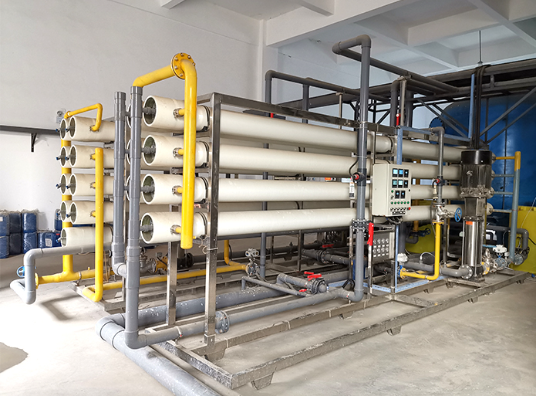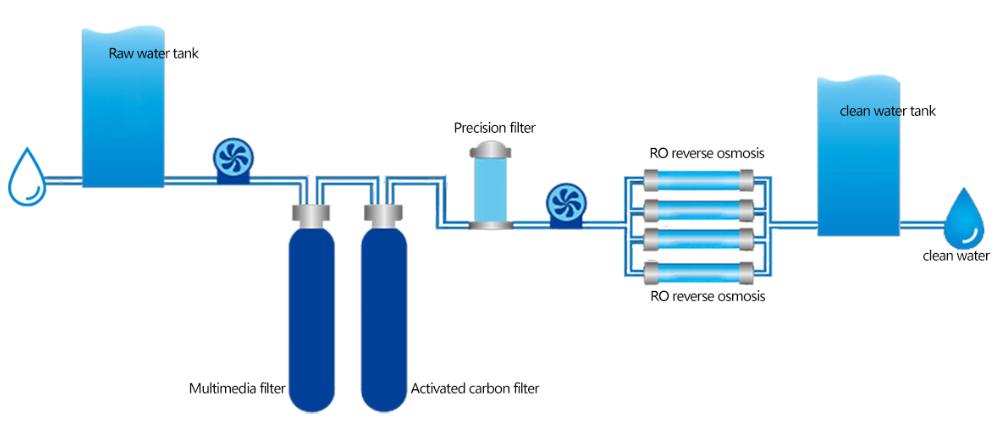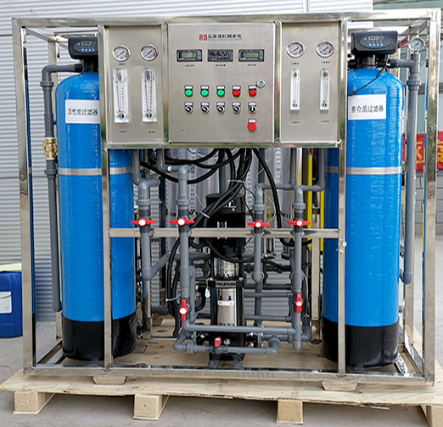What is Reverse osmosis water treatment equipment?
Reverse osmosis water treatment equipment is a sophisticated water purification system that utilizes a multi-step process to deliver high-quality, purified water. The journey of water through this system begins with preliminary treatment processes such as pre-filtration and softening treatment. Once the water is pre-treated, it is pressurized using a pump and passed through a reverse osmosis membrane (also known as an RO membrane).
The RO membrane functions as a super fine filter that possesses incredibly tiny pores. These pores are so minute that they can effectively filter out a vast range of impurities in the water. These include industrial pollutants, heavy metals, viruses, bacteria, organic substances, inorganic substances, and even radioactive substances.
The result of this rigorous filtration process is water that is not only crystal clear but also pure and safe to consume. The reverse osmosis process not only purifies the water but also enhances its taste, making it sweet and refreshing. This makes reverse osmosis water treatment equipment an excellent choice for anyone seeking a reliable and efficient method for purifying their water.

Reverse osmosis water treatment equipment is primarily applied for reverse osmosis treatment processes, and it is widely utilized in various settings. These can range from residential households looking to enhance the quality of their drinking water, to large scale industrial facilities needing to treat and recycle their wastewater, or food and beverage companies wanting to ensure the purity of their products. It can also be a crucial component in medical and scientific research facilities that require ultra-pure water for their operations.
The filtration media used in reverse osmosis equipment is specifically designed to tackle a broad spectrum of contaminants. This includes industrial pollutants that can often infiltrate water sources due to industrial waste or accidents. Heavy metals, which are harmful to human health even in trace amounts, are also effectively filtered by the reverse osmosis process.
Moreover, reverse osmosis is extremely effective in removing microorganisms from water. This includes bacteria and viruses that can cause a range of illnesses when ingested. By providing a thorough filtration process, reverse osmosis equipment ensures the delivery of safe and clean water, free from harmful substances and microorganisms.
The working principle of reverse osmosis water treatment equipment is based on a modern technology called reverse osmosis. This technology effectively improves the purity of water by removing impurities and salts.
At the heart of the system is the reverse osmosis element, which is essentially a semipermeable membrane. This membrane allows water to pass through while blocking the passage of dissolved impurities and salts. The key to this process is the pressure differential on either side of the membrane.
In nature, water tends to move from an area of low solute concentration to an area of high solute concentration to achieve equilibrium, a process known as osmosis. The pressure required to prevent this natural flow of water is called osmotic pressure.
However, in the reverse osmosis process, an external pressure is applied to the side with the higher solute (salt) concentration, which is greater than the osmotic pressure. This forces the water to move in the opposite direction, from the area of high solute concentration to the area of low solute concentration. As a result, water molecules are pushed through the reverse osmosis membrane, leaving behind the dissolved impurities and salts. This process produces purified water on the other side of the membrane. Thus, the principle of reverse osmosis is effectively utilized to purify water in this equipment.

What are the product advantages of reverse osmosis water treatment equipment?
Reverse osmosis water treatment equipment offers a multitude of advantages that make it an excellent choice for water purification:
Exceptional Desalination Rate: This equipment boasts a desalination rate that can reach up to 99%. The primary reverse osmosis system stabilizes the desalination rate above 90%, while the secondary reverse osmosis system can maintain it above 98%. This means that nearly all salts and impurities are effectively removed from the water.
High Degree of Automation: Reverse osmosis equipment can work uninterruptedly for extended periods. It has a high degree of automation, which makes it easy to operate. The water quality it produces is stable, and the process does not result in pollutant discharge, making it environmentally friendly.
Cost Savings: The use of reverse osmosis equipment reduces the cost of chemicals needed for resin regeneration, labour costs associated with the regeneration process, and the cost of treating wastewater resulting from regeneration. This results in significant overall cost savings.
Durability: The frame, piping, and fittings of the reverse osmosis equipment are made of stainless steel and other corrosion-resistant materials. This ensures the system's durability and longevity, leading to lower maintenance costs and a longer lifespan of the equipment.
These advantages make reverse osmosis water treatment equipment a superior choice for those seeking an efficient, cost-effective, and reliable method for water purification.
The technical parameters of reverse osmosis water treatment equipment highlight its superior performance and flexibility:
Filtration Accuracy: The equipment can filter particles as small as 0.0001 micrometers (μm), ensuring an exceptionally high level of purification.
Desalination Rate: The system can achieve a desalination rate of up to 99.8%, effectively removing almost all salts from the water.
Inlet Water Pressure: The equipment can operate with an inlet water pressure ranging from 0.2 to 4 MegaPascals (Mpa).
Water Production: The system has the capacity to produce between 0.5 and 50 cubic meters of water per hour (m3/H).
Source Water Hardness: The equipment can handle source water with a hardness value of less than 10 millimoles per liter (mmol/L).
Discharge Water Hardness: The hardness of the water discharged by the system is less than or equal to 0.03 millimoles per liter (mmol/L).
Process Selection: Users can choose between single-stage reverse osmosis, double-stage reverse osmosis, and stainless steel reverse osmosis equipment according to their specific needs.
Type: The equipment is available in various types to cater to different sectors, including engineering, industrial, and business types.
Customizable: The system can be customized according to different working conditions to meet specific requirements.
These technical parameters showcase the versatility, efficiency, and high performance of reverse osmosis water treatment equipment. With its customizable and flexible features, it can effectively cater to a wide range of water purification needs.









